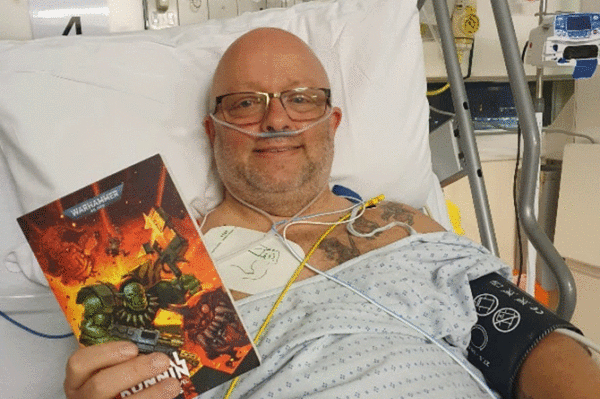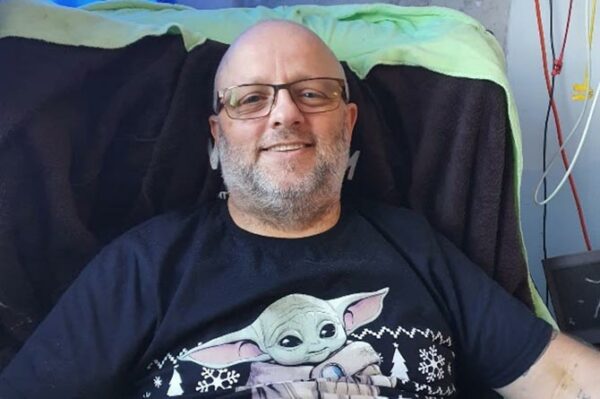Support quality, independent, local journalism…that matters
From just £1 a month you can help fund our work – and use our website without adverts. Become a member today

In November 2021, Peter Belson and his wife, Kelly, were travelling home from their caravan when a sudden ill-turn left Peter’s life hanging in the balance.
Peter, who was 55 at the time, had started feeling unwell, so Kelly took over behind the wheel and they continued their journey home.
Shortly after, Peter, from Caerphilly, cried out in pain and the couple pulled over into a nearby petrol station. By this point, Peter was “grey, clammy and breathing oddly,” explained Kelly.
She noticed a parked police car in the petrol station and ran over to it for help. The police officer called for backup and dialled 999 to ask for the nearest defibrillator.
What is a defibrillator?
Defibrillators can be used to help someone experiencing a heart attack or cardiac arrest.
Currently, there are 6,188 public access defibrillators in Wales registered with the Welsh Ambulance Service Trust and the Circuit – which is a national defibrillator network.
Defibrillators usually cost around £1,300.
Every year, around 6,000 people suffer sudden cardiac arrest in Wales.
Someone experiencing a cardiac arrest will collapse suddenly. They will be unconscious and unresponsive.
Their breathing will also be affected, with some people not breathing at all during a cardiac arrest.
A cardiac arrest often happens without warning.
Without immediate treatment or medical attention, someone experiencing a cardiac arrest will die.
A patient’s chance of surviving an out of hospital cardiac arrest decreases by an estimated 10% with every passing minute.
If you see someone having a cardiac arrest, call 999 immediately and start performing CPR on them.
During the EURO 2020 football match between Denmark and Finland in June, Denmark midfielder Christian Eriksen collapsed to the floor after suffering a cardiac arrest.
He was swiftly treated on the pitch with a defibrillator – which saved his life.
A defibrillator locator can be accessed through the MAS app, which is available on the App Store and Google Play.
Two more officers arrived at the scene with a defibrillator as Peter headed to hospital. Kelly described Peter’s condition at this point as “obviously very unwell”.
“His colour was dreadful, his breathing was very shallow and he was barely conscious,” she added.
It was at this point Peter went into cardiac arrest.
Two of the police officers pulled Peter out of the car and connected him to the defibrillator. This moment, according to Kelly, “felt like ages but was actually only a few minutes”.
After the shock of the defibrillator, Peter regained consciousness.

“They say your life flashes before your eyes, and it definitely did,” Kelly said. “Pete’s eyes opened wide and were staring into space”.
Peter was now stable enough to be transported to hospital as the ambulance arrived. Medics found a block in his arteries and he went straight into surgery.
After suffering multiple cardiac arrests in hospital, Pete had an implantable cardioverter defibrillator (ICD) fitted. This means he should be kept safer should he suffer another cardiac arrest.
Kelly said: “Peter was very unwell, but very lucky that the police officer had been in the right place at the right time.”
Thanks to the police officers’ quick thinking and early defibrillator use, Peter stood a far better chance of survival.
For every minute after a cardiac arrest without action, a person’s chance of survival drops by 10%, according to St John Ambulance Cymru.
Peter said: “It’s been a long recovery process which is ongoing – cardiac rehab, exercise, diet and so on, but I’m getting there. I’ve been listening to my body and learning to say no.”
Peter is now supporting the St John’s Ambulance Cymru’s ‘Defibruary’ campaign, which aims to raise awareness of defibrillators throughout the month of February.
He said: “Defibrillators save lives. It saved mine.”
An online platform run by the British Heart Foundation, The Circuit, includes a directory of defibrillators which are registered with it. This can be used by the emergency services to direct people to their nearest defibrillators in an emergency.
The Circuit has 50,000 defibrillators registered on it, but the British Heart Foundation estimates there are 100,000 across the UK.
In Caerphilly County Borough, the Tommy Cooper Society has fundraised for multiple defibrillators as part of its Tommy’s Ticker campaign.
Defibrillators funded through the Tommy’s Ticker campaign
- Caerphilly Library (fitted April 15, 2014)
- Caerphilly Visitors Centre (April 15,2014)
- Blackwood Miners’ Institute (July 16, 2015)
- Bedwas Workmen’s Hall (August 11, 2015)
- Rudry Parish Hall (November 19, 2015)
- Caerphilly Castle (December 1, 2015)
- Aber Valley YMCA (September 30, 2016)
- Caerphilly Workmen’s Hall (October 9, 2016)
- Vanguard Centre (October 17, 2017)
- St Martin’s Church (December 1, 2017)
- Penallta Runners (May 26, 2018)
- Caerphilly Miners’ Centre (September 15, 2018)
- Llanbradach Community Centre (November 3, 2019)
- Scholars Restaurant, Coleg y Cymoedd, Ystrad Mynach (March 18, 2022)
How to use a defibrillator
- Step 1: Turn the defibrillator on by pressing the green button and follow its instructions.
- Step 2: Peel off the sticky pads and attach them to the patient’s skin, one on each side of the chest, as shown in the picture on the defibrillator.
- Step 3: Once the pads have been attached, stop CPR and don’t touch the patient. The defibrillator will then analyse the patient’s heart rhythm.
- Step 4: The defibrillator will assess whether a shock is needed and if so, it will tell you to press the shock button. An automatic defibrillator will shock the patient without prompt. Do not touch the patient while they are being shocked.
- Step 5: The defibrillator will tell you when the shock has been delivered and whether you need to continue CPR.
- Step 6: Continue with chest compressions and rescue breaths until the patient shows signs of life or the defibrillator tells you to stop so it can analyse the heartbeat again.
Source: British Heart Foundation
This article has been amended to make it clearer that The Circuit database is used by the emergency services to direct people to their nearest defibrillator.
Support quality, independent, local journalism…that matters
From just £1 a month you can help fund our work – and use our website without adverts.
Become a member today
